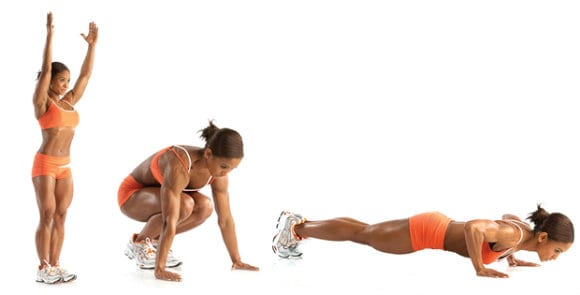By the healthiergang writer , student in Medicine and Surgery.
In Burpees
“The exercise you will hate to love”; is the first thing I read when I went looking for what Burpees were. This already made me a little anxious thinking about what awaited me. It's a great metabolic and gymnastic exercise.
Burpees are common in functional style training, among martial arts practitioners, in American football, among the Marines. This exercise provides general conditioning and employs the large muscle masses of the whole body.
Initially it was born as a physical test to evaluate the abilities of the subject during the visits for the American military corps; it dates back to about 1930, taking its name from the physiologist H. Burpee and used during recruiting operations during the Second World War. The subdivision of the various passages from one position to another determines the coordinative and muscular-articular complexity.
How to do them
Before starting to exercise it is always a good idea to do a good general warm-up, some push-ups and a few squats.
We start in an upright position; we pass into a squatting position with our hands on the ground after which we throw our feet back into a push-up position, with the chest touching the ground and with the elbows close to the torso; with a quick movement we extend our arms doing a flexion and jump back into the Squat position; from here we jump up and repeat.
Generally when you learn the exercise, starting from scratch, you try to divide the movements and break down the gesture into 4-5 steps. The more you become practical and the more you acquire the motor protocols, the shorter the execution time and the fewer steps we will perform.

In fact, the first part, which involves the passage from the upright position to the one on the ground, can be performed with a single explosive movement, without first passing from the squatting position, literally throwing us to the ground; even in the last phases we can speed up the movement by practicing an explosive push-up which, together with the push of the legs, takes us directly to the Squat position and then jump upwards.
The basics
From the explanation of the exercise you can understand the basic movements to be able to master: surely you need to have good power in push-ups and squats, so as to be able to complete the exercise by performing the jump, but also good stability given by the solidity of the core ( especially when we break the gesture and find ourselves, after the flexion, in a plank position with our arms extended).
But the involvement, as mentioned before, is global: muscles of the trunk (core for stability), both those of the upper limbs (biceps and triceps brachial combined with the pectoral muscles) and the stabilizing muscles of the back and shoulder (trapezius, rhomboid, rotator cuff).
And because of its complexity, newbies should not immediately try their hand at its execution because the exercise causes strong stress on the spine and knees, increasing more and more with each jump, so you must have at least a minimum of preparation in order to have already acquired a good strength and elasticity.
variants
From the classic version exposed before, many variations have evolved that lead to modifications of some points or even to the addition (as if it were not already expensive enough) of movements.
Burpee pull-up: While performing the upward jump, it is possible to grab a bar or rings and perform a pull-up. In this case we have a greater organic commitment and toning work on the traction muscles (Great Dorsal, Biceps Brachialis, Rhomboids).
Burpee medball: in this case when we lower ourselves we do not place our hands on the ground but directly on the ball, increasing the destabilizing component; the push-up can also not be done, and when you get upright you also bring the ball up.
Burpee with Snatch / Clean: Grabbing a dumbbell, a barbell or even 2 Kettlebells in this case instead of performing the jump upwards, you perform a Snatch by bringing the tool in question above the head or a clean bringing it to the chest. Then the load is brought back to the ground and continues with the backward momentum. This variant activates the explosive components more, having the onerous final task of having to lift a weight. The push-up can also be omitted.
Burpee over the bar: the gesture is the same as the classic one but the final jump must be made from one side of a bar to the other, generally barbells loaded with Olympic discs are used, thus having to jump on average around 22,5 cm. This year at the rossfit Regionals, in one of the events we saw the execution of the Burpees beyond a mattress, which ranged from a few cm to about 60 cm !! So we can use any object.
One Arm or One Leg Burpee: in the first case, using only one hand as a support and putting the other behind the back, we lower ourselves to the ground and throw our legs back: we can also not perform the push-up and remain in the plank position ; as regards the second, the exercise is the same as the original only that we place only one leg at a time on the ground: in this case the movement that sets us from the horizontal to the vertical position must be powerful and decisive.
Plyo Lunge Burpee: After doing the burpee, we do two plyometric lunges in place (one per leg) and start over.
These are just a few examples of how to make Burpees even harder and more fun; each of us can add elements to his liking and customize his own training routine.


























